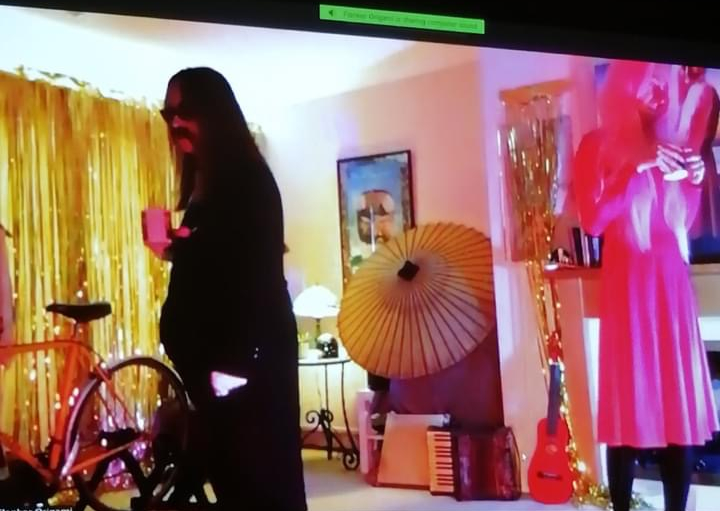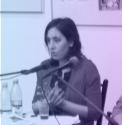Looking from the Moon - Digital Sustainability at Transit 10 Festival
A week prior to performing Organic Theatre’s Flanker Origami at Transit 10 Festival, I start decluttering the house ready to become the digital stage for the performance on Thursday 9th June, when at 9am (UK time) we were to connect with the Transit artists and participants gathered in Holstebro, Denmark.
From the beginning of the festival, my ‘at home’ calendar became filled with chores and my days started with cleaning rituals bridging the domestic space into the platform for digital engagement with the festival attendees. This would be the first time that John Dean (my co-deviser/performer) and I were aware that our ‘official’ group of spectators were physically together, sitting in a theatre space and witnessing the work without interacting directly through personal devices, as we are beamed in as ghosts inside Helen Varley Jamieson’s computer machine, projected through her laptop onto a big screen mounted on the stage area of the Black Room, one of the performance spaces at Odin Teatret - NTL.
While our digital bodies were amplified and expanded into a cinematic experience in the theatre, the house acted as a stratigraphy of lived-in spatial arrangements, which needed to be reconfigured for the performance: small objects end up in a large tin box I once brought back from India (in my travelling years), which then become part of the living room set design, covered by an intricately ornate black scarf I inherited from my mother, who was a singer and actress. Autobiographical materiality overwrites the living space. Books scattered around, accumulated in piles to fill corners, will be stored under the dining table. Personal items, laundry, itinerant bags end up - temporarily - in cupboards already full of stuff waiting to be sorted and/or recycled. Chaos and precariousness appropriate the domestic side of my life to give space to the controlled and carefully constructed environment supporting the digital performance. The purpose is to create visual texture, conveying tactile, synesthetic sensations through the screen, alongside the essence of us as a life and artistic couple trapped amidst personal belongings and theatrical fossils excavated from our previous performances.
Costumes are hanging on a stand as displays of theatrical potential, masks are positioned on the walls instead of decorative plates, or on bookshelves as gargoyles of embodied theatre knowledge. An old accordion, drums and guitars fill gaps between the real fireplace and the covered TV.
It is our house, and these are our artifacts, instruments, props and dresses of a life in art exposed as a background reminder of who we are, and our identity as theatre makers. Yet as I move along the Transit timespan, day after day as the time of the performance approaches, my home loses its protective qualities to morph into a creative cave of dreams, subtly mutating its environment into an act of becoming something else, making room for the unexpected, on the edge between private and public. A place through which we intend to affect the digital spectators’ perception of the real spaces we inhabit daily.It is this non-representational but rather affective, personal, imaginative place - alongside the creative gestures of preparation - that becomes my embodied experience of Transit 10 Festival lived in a contiguous time and space from Scotland.
On the other hand I follow the Transit Facebook group on social media, and I receive posts from Julia Varley, who this year called the courageous artists of the Magdalena Project to spark their creativity and mingle on the premises of Odin Teatret for the tenth time. I also read posts of performers, directors and creators whom I’ve never met in person but befriended virtually during Bodies:On:Live, the first online Magdalena festival, in June 2021.
I perceive the dimension of in-person encounters and with a leap of my imagination, I feel my senses responding to the socio-materiality of travels, welcoming, hugs, shared embodiments, big and happy smiles, selfies and long-awaited reunions. I recompose and reconstruct the immanence of Transit 10 at Holstebro through browsing Instagram and individual profiles, each recounting their own festival experience, each adding their lived-through fragment to the overall picture of what is happening in the physical spaces, as an evidence of embodied togetherness.
Retracing all these different and unique (digital) proofs of geolocated human activity, be it that of performers or that of spectators, is the mapping that leads me to that shared, creative space I was invited to be part of but not to attend, if I wanted to bring Flanker Origami to the Festival. My creative conditions implied remoteness and were determined by ‘staying at home’.
While working through the discipline of assembling my personal space for the performance, my brain was puzzling with these mediated viewpoints and the act of joining the dots through a dissociated experience. As I was relying on others’ technological devices sending and receiving images and comments to follow the event, Transit was performed through social media for those who, like me, were not in presence. The shared photo/video documentation was pointing at the materiality of the Transit event through the immateriality of the technology for those who were remote, while reinforcing the sense of a communal memory for the group in Holstebro.
Through this digital reconstruction, I carved a sense of the atmosphere at Transit, I remained connected through multiple platforms, I activated my digitalised bodymind until I perceived myself to be on the wavelength of my fellow artists and of attendees. I added my energy to the flow of creative participation in a spiritual yet concrete act of connection from a far away land of invisibility. Did anybody hear me? Was I alone or together? Was being far away from the materiality of bodies purely about being disconnected? And was Organic Theatre’s digital presence a temporary pivot to share Flanker Origami at Transit or were we another kind of presence within the festival, which added a porous digital space to the physical one?
It’s Wednesday night, and we are getting ready to perform through the wires. We accellerate against the usual bedtime routines as we strive to have the get-in completed before going to sleep, to wake up within our Flanker Origami home transformation.
Doing the get-in inside a homely place which you are already in, emotionally and psychologically, is on one hand a pretence, on the other it requires that we form a different belief about our personal space, where new rituals surface because of the special theatrical encounter we are about to instigate online.
Thursday, 8am. Our focus on the performance merges with the mundane activity of having breakfast, showering, washing up what’s in the sink to check the kitchen as one of the framed spaces on the digital screen, and bringing every ambience of the house into a neutral state, ready to vibrate with the frequency of an altered space, overwriting private pockets of messiness, which we will have to deal with after the performance.
The room, the furniture, the objects have an aura of being untouchable until they serve the performance. Home as we know it transcends its geographical roots, and it becomes a space shuttle ready to fly into infinity.
It’s almost time to meet with Helen and Claudio Coloberti to check that the connection, Wi-Fi and screens in the Black Room are working as planned. As I come closer to the start of Flanker Origami, I enter a liminal state of passing through a rite of passage which is consumed between two spheres - the private and the public, merging and overlapping in my fluctuating perception of what is part of my daily life and what creates an altered reality in the here and now.
To this situation, as a performer I need to add the circumstances engendered by working with and through the technology. Flanker Origami exists on and for the digital medium we use, a Zoom webinar which opens up interactivity through the chat, opening a window into participation and individual online engagement by our spectators.
Part of the feeling of liveness we want to conjure through the screen is created through engaging the bodily experience of typing or dancing and being alert to potential invitations by us as digital performers. To have digital spectators and ensure that we had enough interaction via the chat, I invited fellow artists to join us on the webinar as well as a team of Festival programmers from Hong Kong, while at the same time we were presenting Flanker Origami as a practice research output for our colleagues of the Centre for Communication, Culture and Media Studies at Queen Margaret University who were connecting in from campus.
All of a sudden we realised that although the performance was for/at Transit in Denmark, it was simultaneously - albeit in different time zones - in London (streamed on a mobile device on the Tube), in Glasgow (witnessed from home), in Edinburgh (on a big screen in a university classroom) in Plymouth (at home, first experience of the day after breakfast!), Australia and Hong Kong.
Beside the different locations, the kind of digital experience unleashed was also diverse - different devices, cities, viewing conditions, which enable a different kind of presence, participation and readings of the work.
This makes us think about how hybrid situations organised for live online performances can be a viable solution to guarantee accessibility and sustainability for our creative work, whether it is originally created for digital engagement or not. Is this a possible template for ensuring that one production effort has more currency and opportunities to grow and develop beyond the specific context and location of the main event? This was learnt during Bodies:On:Live - Magdalena:On:Line, which paved the way for a rigorous consideration about the future of theatre and its relationship with new technologies.
So, performing from home, was I or was I not at Transit? What space does my disconnected body occupy in the geographical assembly from where physically crossing political and territorial borders are a significant part of giving the meeting its purpose? Those once distant were now together, I was together yet distant.
In this fluid positioning, Transit 10 held for me a specific meaning alluding to the transitory/transitional passages between liminal spaces of doing and knowledge exchange, through the fluid and porous field of technologically enabled performance.
 I was in-transit between different countries and continents, across geographical borders defied by the technology.
I was in-transit between different countries and continents, across geographical borders defied by the technology.
I was looking from the moon to a land of sensorial belonging, reaching out to the Festival community through my own glitchy, imperfect, disconnected digital image. A disembodied voice, yet longing to be ‘there’.
Scotland/Italy, 2022






Comentarios
A blog on the experience of performing Flanker Origami live online at Transit 10 Festival - The Splendour of the Ages.